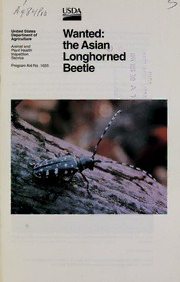
Wanted, the Asian longhorned beetle PDF
Preview Wanted, the Asian longhorned beetle
Historic, Archive Document Do assume not content reflects current scientific knowledge, policies, or practices. United States Wanted: Department of Agriculture the Asian Animal and Plant Health Inspection Longhorned Service ProgramAid No. 1655 Beetle TheU.S.DepartmentofAgriculture(USDA)prohibitsdiscriminationinallitsprogramsand activitiesonthebasisofrace,color,nationalorigin,gender,religion,age,disability,political beliefs, sexualorientation,ormaritalorfamilystatus. (Notallprohibitedbasesapplytoall programs.)Personswithdisabilitieswhorequirealternativemeansforcommunicationof programinformation(Braille,largeprint,audiotape,etc.)shouldcontactUSDA'sTARGET Centerat(202)720-2600(voiceandTDD). Tofileacomplaintofdiscrimination,writeUSDA,Director,OfficeofCivilRights,Room 326-W,WhittenBuilding, 14thandIndependenceAvenue, SW,Washington,DC20250- 9410orcall(202)720-5964(voiceandTDD).USDAisanequalopportunityproviderand employer. IssuedJune 1999 Photocredits:Thephotographonpage4wastakenbyretiredAPHISemployeeJohn Burnett.AllotherimageswerephotographedbyAPHIS'KenLaw. Introduction TheAsian longhomedbeetle (Anoplophora glabripennis) has earned the title ofpestbothhere and in its home country ofChina. This beetle is a serious pest ofhardwood trees andhas no natural enemies in the United States. Ifthis insectwere to become establishedhere, it could turn into the gypsy moth ofthe 21st century, destroying millions ofacres of America's treasuredhardwoods, including national forests andbackyard trees. The beetle has the potential to damage such industries as lumber, maple syrup, fruit, andtourism. Butthanks to observanthomeowners, the beetle's sneak attack on the United States has been discovered. In New York and Chicago, residents have alerted the U.S. Department ofAgriculture's (USDA)Animal and Plant Health Inspection Service (APHIS). NowAPHIS, togetherwith State and local governments and local residents, is working to halt the march ofthe beetle. But in orderto be successful, everyone needs to be involved inprotecting trees fromthis pest. — Figure 1 TheAsianlonghornedbeetle,ifitbecomesestablishedin theUnitedStates,couldturnintothegypsymothofthe21stcentury. 3 The Beetle TheAsian longhornedbeetle is abig, showy insect: it is about an inch long, shiny, andblackwithbright white spots. Each adulthas apair of curvedblack-and-white antennae that are even longerthan its body. TheAsian longhornedbeetle attacks healthy hardwoods ofmany different species, including Norway, sugar, silver, andredmaple, horsechestnut, poplar, willow, elm, mulberry, andblacklocust. Adultfemalebeetles chew holes in the barkofthe trees to lay theireggs.Afterhatching, the white, wormlike immaturebeetles bore into tree trunks andbranches, causing sap to flow heavily from wounds.Afterthese beetles mature, they will chew theirway out ofthe attacked tree, leaving behind exitholes about ahalfinch in diameter. AdultAsian longhornedbeetles are active only during the summerand fall months. Theyreside deep inside infestedtrees during the rest ofthe year. This factmakes it virtually impossible to eradicate these pests with insecticides. — Figure2 APHIShastracedtheAsianlonghornedbeetle backtosolidwoodpackingmaterialsfromChina. 4 There are no known lures to attractAsian longhornedbeetles. Blacklight traps, which attract otherwood-boring pests, do not work on this one. Research continues as scientists experiment with traps using sex attrac- tants (pheromones), like those used for gypsy moth and Mediterranean fruitfly. In the absence ofatrap, APHIS and cooperating State inspectors must tackle the difficulttaskofcompleting a survey ofbeetle-infested areas. Inspectors must examine individual trees for exit and entry holes. They also lookforpiles offrass (insect waste and sawdust) at the base of infestedtrees and inbranch crotches, andfor sap leaking from wounds in the trees. Unseasonable yellowing or drooping ofleaves when the weatherhas notbeen especially dry are signs that theAsian longhorned beetle is present. Leafsymptoms show up when the immature insects, growing inside the tree, have bored through tissues that carry water and nutrients to the leafy canopy above. Once the pesthas sufficiently disrupted those pathways, affected trees will die. 5 The Threat to U.S. Trees Asian longhornedbeetles normally do not spread quickly ontheirown. When they become establishedin alocation where there arehardwood trees, the beetles attackone or afew trees at first, eating until the tree is exhausted as afood source. Then they spread to nearby trees. Undertheir ownpower, Asian longhornedbeetles can fly hundreds offeet. With a wind assist, they can go even farther. However, people can unintentionally increase the speed or spread ofan infestation by cutting or trimming an infested tree and moving the wood, which contains maturing beetles, elsewhere. To limit human-caused spread ofthe Asian longhornedbeetle, officials fromthe State and Federal governments establish quarantines in areas where infestations have been discovered. The infested areas inNewYork and Chicago have bothbeen quarantinedto preventthe movementofinfested wood. No one may remove firewood, trimmedbranches, stumps, roots, orotherwood — debris fromthese quarantine Figure3 Asianlonghornedbeetledamage. areas. With no traps andno insecticides, the only way to eradicate the beetle is to remove and destroy infested trees, an expensive, difficult, andunpopu- laroperation. Damage fromthe 1996 infestation inNewYorkcost State andFederal governments more than $5 million. Thousands ofstreet and residential trees in NewYorkCity and onLong Islandhave been cut, chipped, andburnedto preventthe spread oftheAsian longhornedbeetle. 6 APHIS' Role in Excluding Foreign Pests How did theAsian longhornedbeetle getto the United States?APHIS pestrisk analysis indicates that ithitchhiked its way into the United States in solid woodpacking materials, such as pallets and crates, from China. — Figure4 Currently,theonlywaytoeradicatethebeetleisto cut,chip, andburninfestedtrees. APHIS analyzes threats to U.S. agriculture and develops importrestric- tions on commodities based on the risks they present. In the last 13 years, trade with Chinahas increased tremendously, to $73 billion ayear (up fromjust $5 billion in 1985). As aresult, the volume ofpallets and crates 7 passing throughports ofentry has grown exponentially because trade goods are generally shipped in wood packaging materials. This packaging material can conceal abroad spectrum ofpests. The best way to fight theAsian longhornedbeetle and similarnonnative woodborers is to exclude such pests from the country in the firstplace. To stop this specific beetle's mode oftransportation, APHIS has made regulatory changes thatrequire all solid wood packing materials imported into the United States from China and Hong Kong to be heat treated, fumigated, ortreated with preservatives prior to departure from China. APHIS also requires that each shipment from China that contains solid wood packing material be accompanied by a certificate, issuedby the national government ofChina, stating that the solid woodpacking material has been treated. In orderfor these regulatory changes to be successful, importers ofChinese goods must follow the new rule. APHIS will continue to educate cooperators and stakeholders about the impor- tance ofexcluding theAsian longhorned beetle and otherforeign pests. APHIS Plant Protection and Quarantine officers at U.S. ports are the first line ofdefense against exotic plant and animal pests and diseases.APHIS portpersonnel will continue to inspecthigh-risk cargoes fortheAsian longhorned beetle and otherpests. In addition, all international passenger baggage, cargo, packages, mail, and conveyances are subject to inspec- tion upon entry into the United States. 8
